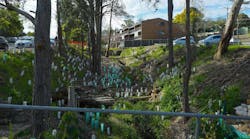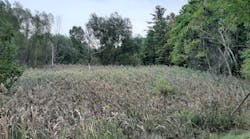How LiDAR Works
LiDAR technology is similar to radar. A scanning laser unit is mounted in a camera port on an aircraft. As the aircraft flies along a line, the laser unit emits a stream of light pulses – up to 10,000 per second – in a side-to-side motion perpendicular to the aircraft’s direction of flight (see graphic). These pulses “bounce” off of surfaces – including tops of trees, cars, buildings, and, of course, the ground – capturing enormous amounts of high-resolution topographical data in the form of elevation readings.
The time it takes for each pulse to return to the aircraft is recorded, along with the angle off nadir (the perpendicular point) at which each pulse was emitted. Airborne GPS data also are recorded at a rate of 1 Hz for the entire session, and an inertial measurement unit provides altitude of the aircraft at a rate of 50 Hz for the entire session. During postprocessing, the slant distance between the aircraft and the ground for each returned pulse is calculated as half the time it takes for a laser pulse to travel from the aircraft and back, multiplied by the speed of light. Each slant distance is then corrected for atmospheric conditions, and for the roll, pitch, and yaw of the aircraft, using the IMU data.GPS data are processed separately and imported into the LiDAR solution; each corrected slant distance is transformed to a ground surface elevation. Additional software is used to generate contours, to ensure quality control of the digital terrain model, and to study certain aspects of the data, such as calibration parameters.Applications and Benefits of LiDARLiDAR can be used to capture points within limited-access areas. Shorelines, airports, high-security installations, and military bombing ranges are examples of areas in which LiDAR has useful application. Also, LiDAR is useful for mapping areas with poles and towers and for obtaining elevations of power lines. LiDAR allows generation of digital elevation and terrain models in areas with hills, heavy vegetation, or shadows. This often eliminates the need for survey crews to return to the field to capture points that could not be compiled photogrammetrically.LiDAR makes surveying possible during day or night in dry conditions. LiDAR projects can be flown during any sun angle and during overcast conditions as long as the ceiling is above the aircraft. However, LiDAR flights should be minimized during hazy conditions and should not be conducted in rain or mist.

